Captain_Oblivious
DIS Dad #257, Galactic Salad Dodger
- Joined
- Nov 10, 2008
- Messages
- 13,473
Chapter 18: You Came Here In That Thing? You’re Braver Than I Thought.
Here’s the best, most detailed, most exciting description I can muster for the morning’s drive from Kansas City across Missouri to St. Louis:
It took us four hours to get there.
We had our customary PB&J on the way and arrived just after noon. We found a parking space in a garage in downtown St. Louis right next to the new Busch Stadium, home of the St. Louis Cardinals. As it so happens, that was our destination.
Being a stereotypical red-blooded American male, I enjoy going to baseball games. My sons, also being stereotypical red-blooded American males, also enjoy going to baseball games. The girls, being stereotypical American females, would rather sit through a C-SPAN marathon than subject themselves to a baseball game. So, when planning these trips, I have to work to balance the boys’ desire to see games in various stadiums around the country versus the girls’ gag reflex. If you recall, we had originally held tickets to watch the Phillies play the Twins in Minneapolis on the first night of the trip, only to be forced to sell the tickets when our flight was cancelled. So we definitely owed the boys on that front.
I’d wanted to check out the St. Louis baseball stadium mostly because it was fairly new and had killer downtown views. St. Louis is well-known for being a big-time baseball town and I thought it would be fun to see a game in that atmosphere. However, in researching ticket prices for my family, I found that the cost would be roughly equal to buying my own cruise missile. I could really use a cruise missile, so I chose to save the money and not buy tickets to a game.
Instead, I went with my usual fallback plan, and got tickets for the stadium tour. In this case, the tour also included admission to the St. Louis Cardinals Museum next door to the stadium, so we headed there first.
The museum is, as you’d expect, an ode to all things Cardinals. Not being a Cardinals fan, I didn’t have a real attachment to anything in particular. However, they had some fun exhibits for the kids and some historical artifacts that appealed to me as a baseball fan.
For example, the greatest St. Louis Cardinal of all time is Stan Musial. In fact, he’s one of the greatest baseball players of all time. They had a copy of his original contract framed and on display, showing that he played for the princely sum of $750/month. Typical overpaid ballplayer.
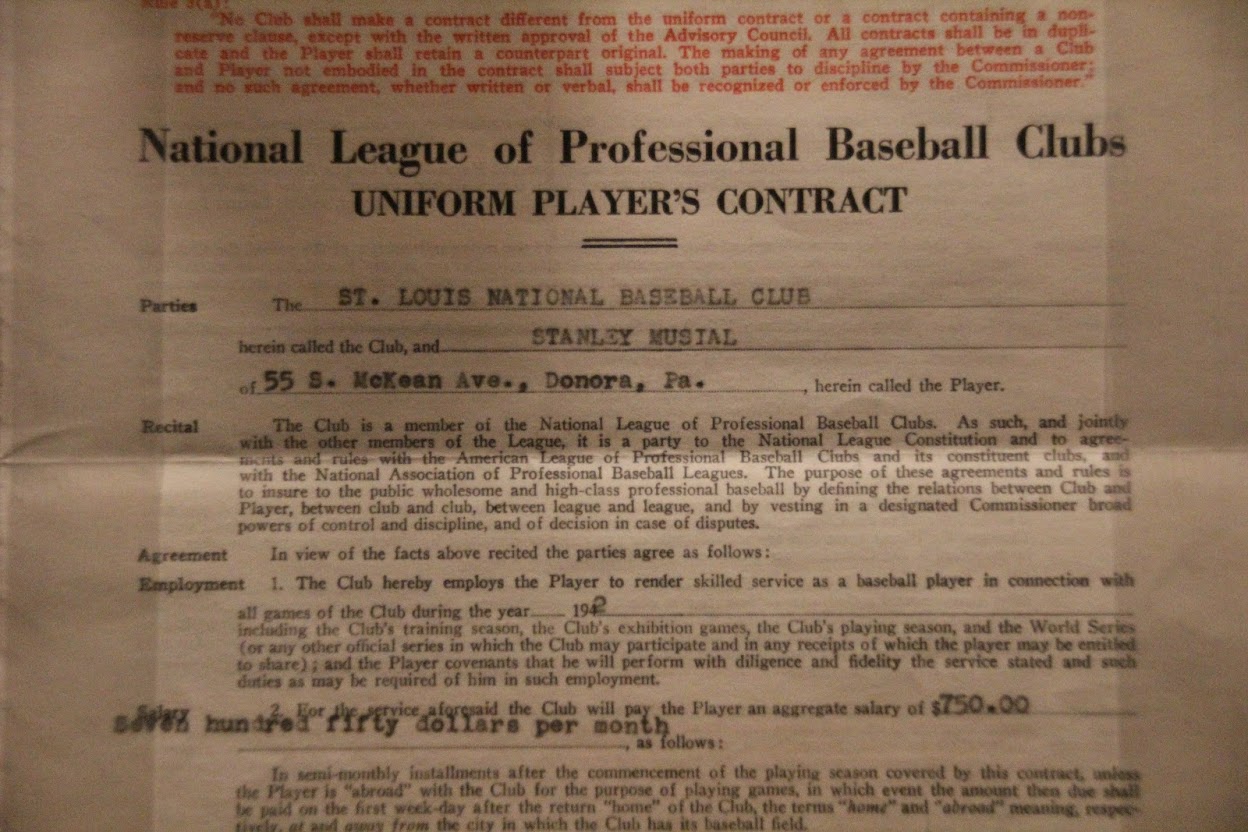
Nearby was a sound booth where the kids could record themselves announcing a home run in the World Series. They had a great time with this, and definitely have a future…in something other than broadcasting.
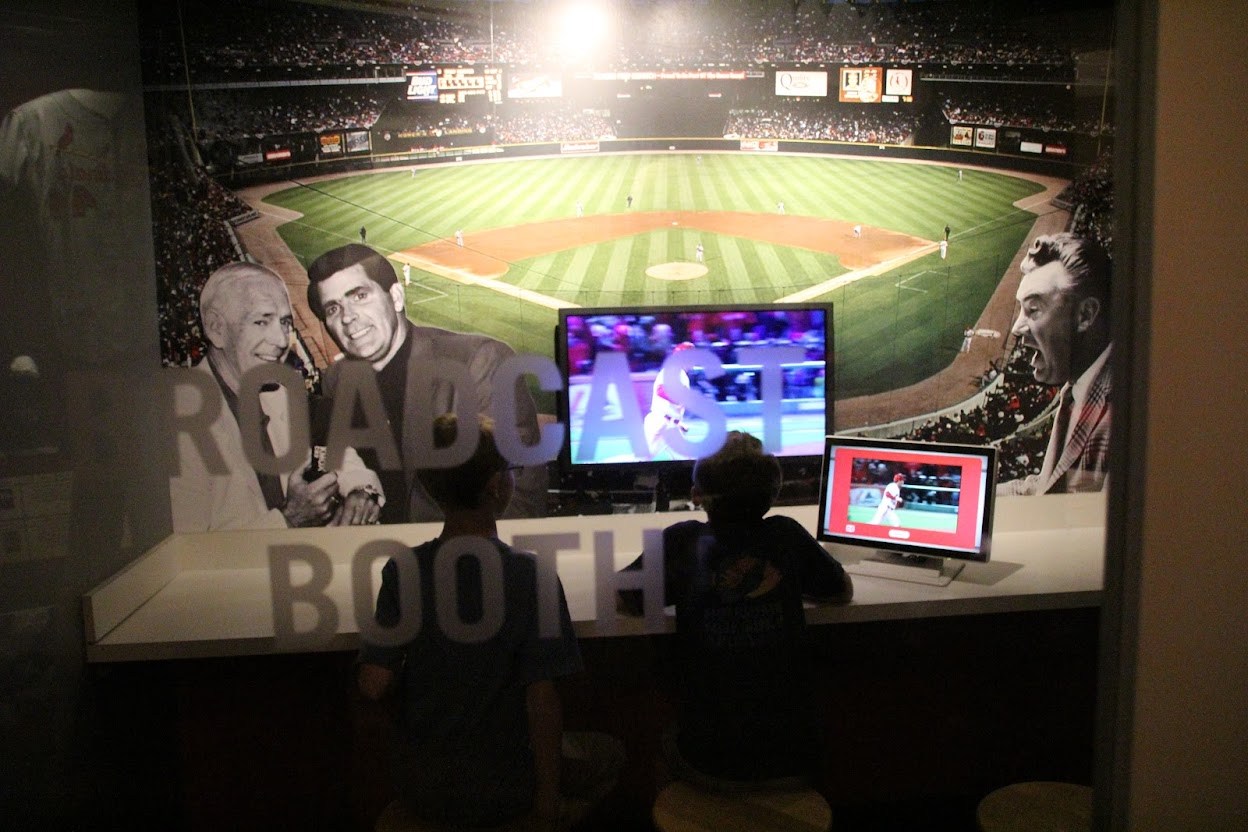
At another exhibit, visitors had the chance to hold the actual bat used by a Cardinals great. The choices were Stan Musial, Ozzie Smith, Willie McGee, and some other dude. Honestly, as soon as I heard Musial, I knew what my choice was. None of the other players were close to his level.
There was a lady stationed at this exhibit whose sole purpose appeared to be to make sure that none of us could actually hold any of the bats for longer than 0.7 seconds. The Bat Nazi also helpfully positioned her chair right in the photo area and then badgered me the whole time about not being allowed to swing, making sure everyone got a turn, blah blah blah.
Lesson #1: Don’t annoy someone holding a baseball bat.
Anyway, we swallowed our irritation long enough to take some photos. I’m crowding the plate because of her stupid chair, so it looks like I’m just begging for the pitcher to bean me with a heater.

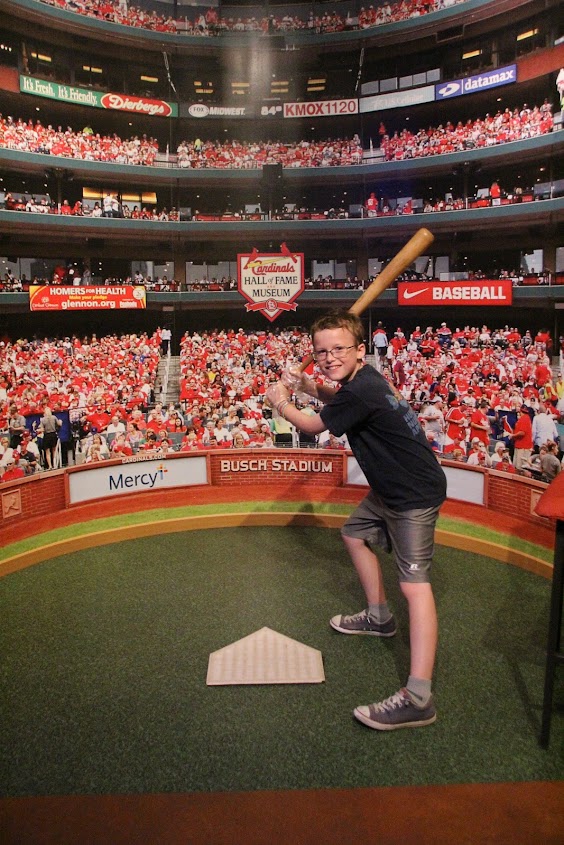
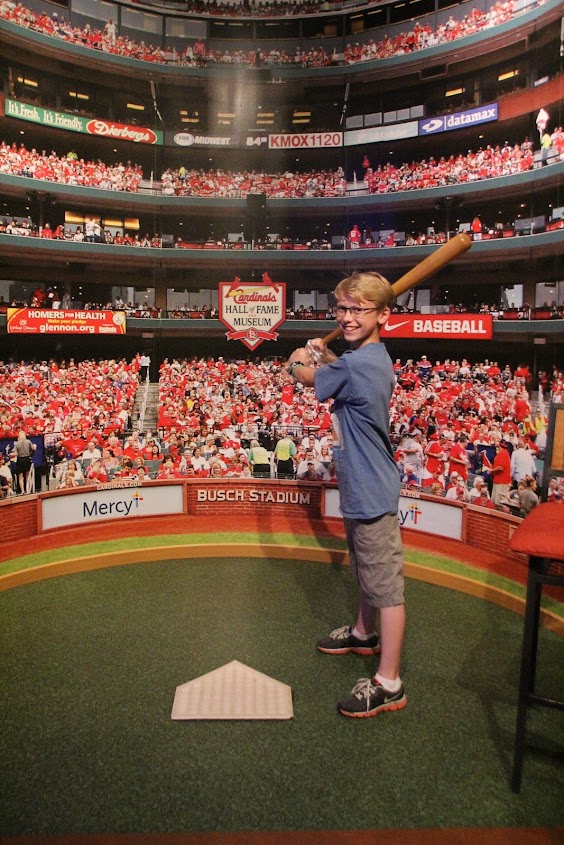
We finished up in the museum and walked across the street to Busch Stadium to meet up with our tour group. I always enjoy baseball stadium tours because you typically get to visit some of the off-limits areas of the stadium, such as the press box, luxury suites, and dugout.
For the most part, we enjoyed the tour. There were only two problems. First, our tour guide was an obvious trainee. The veteran guide was walking along behind us, and shared some history about Stan Musial at one point that indicated he was much more knowledgeable (and a much better story-teller) than Mr. Trainee. The second disappointment was that we would not be allowed on the field, because the Milwaukee Brewers were in town and decided they wanted to have some early batting practice well ahead of that night’s game. So we had to content ourselves with standing near the field. Stupid Brewers.
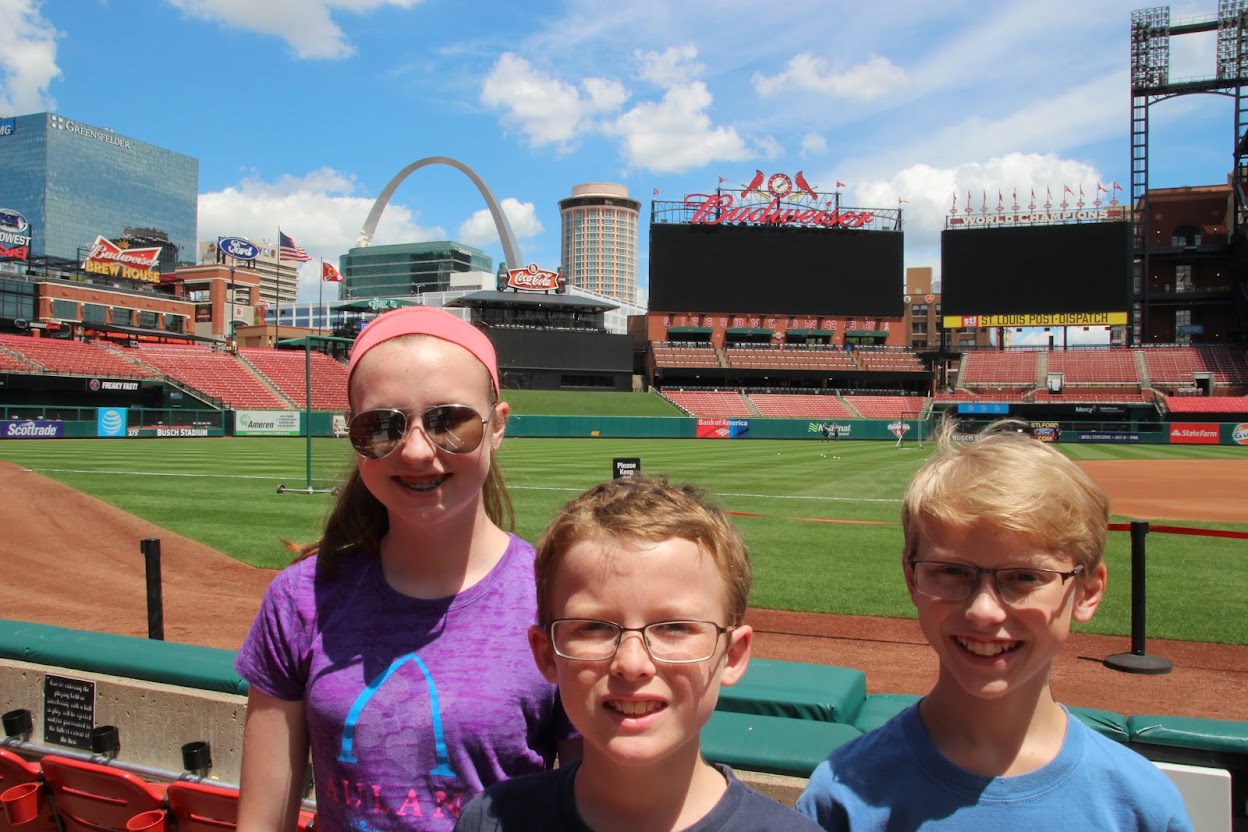
Some of the historic team logos were on display, including this one dubbed the original “Angry Bird”.
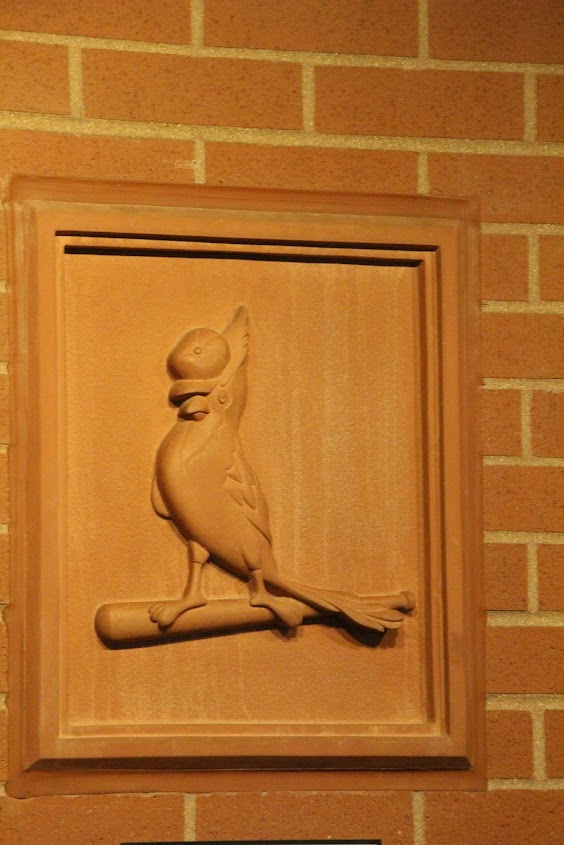
This led to Sarah’s Angry Bird impression:
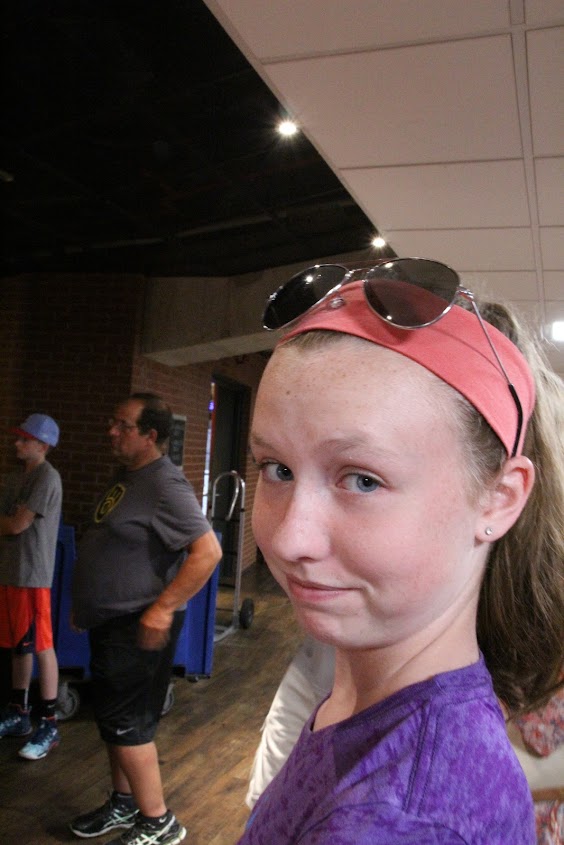
We visited the press box and a luxury suite. And judging from the spray pattern of baseballs, I’m going to back off my initial feelings of disappointment. Clearly, the Milwaukee Brewers needed the extra practice.
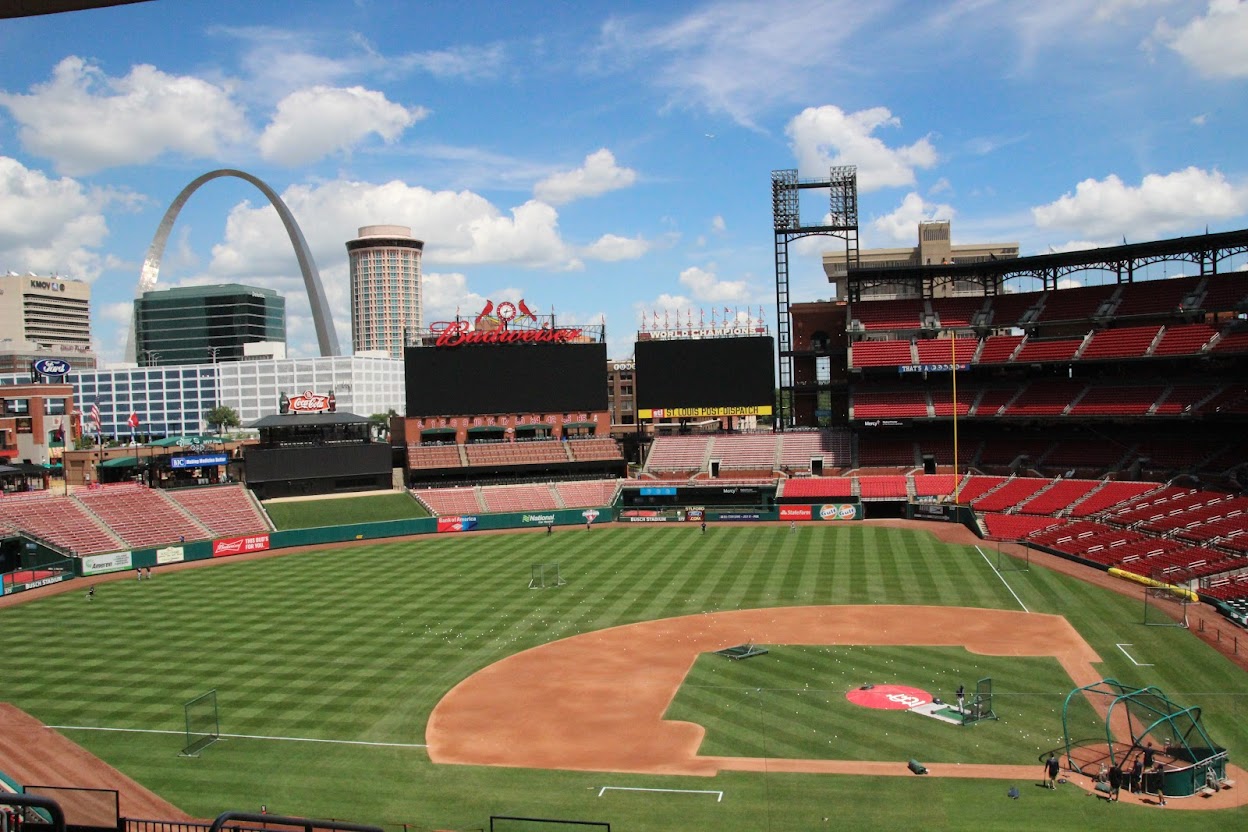
Overall, the boys and I were glad to have been able to see the stadium and check out some of the exhibits. And the girls were glad that it didn’t last as long as a typical baseball game.
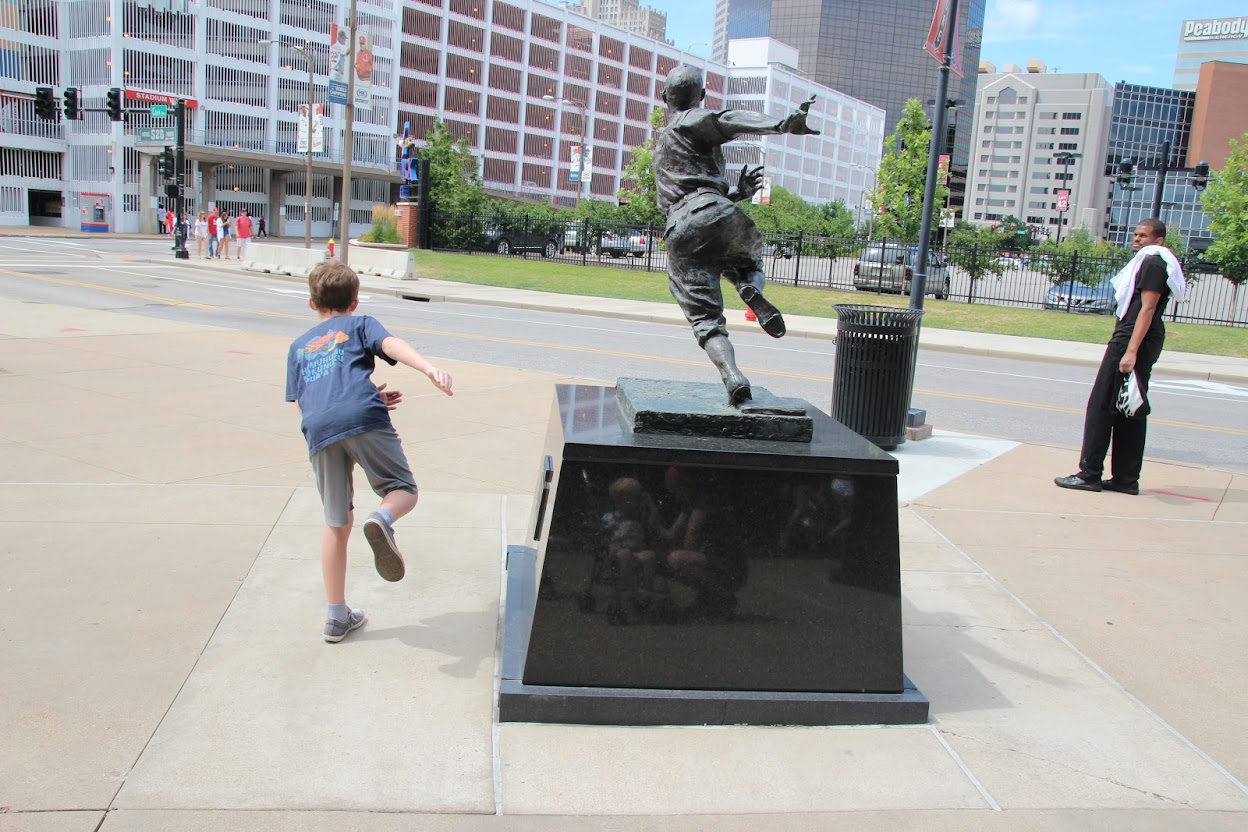
A walk of only a couple of blocks took us to the Old Courthouse, the temporary visitor center for the Jefferson National Expansion Memorial. The normal visitor center is actually located at the riverfront, right underneath the famed Gateway Arch. However, the entire riverfront area was undergoing a massive renovation at the time, so much of the park area bordering the Mississippi River was closed.
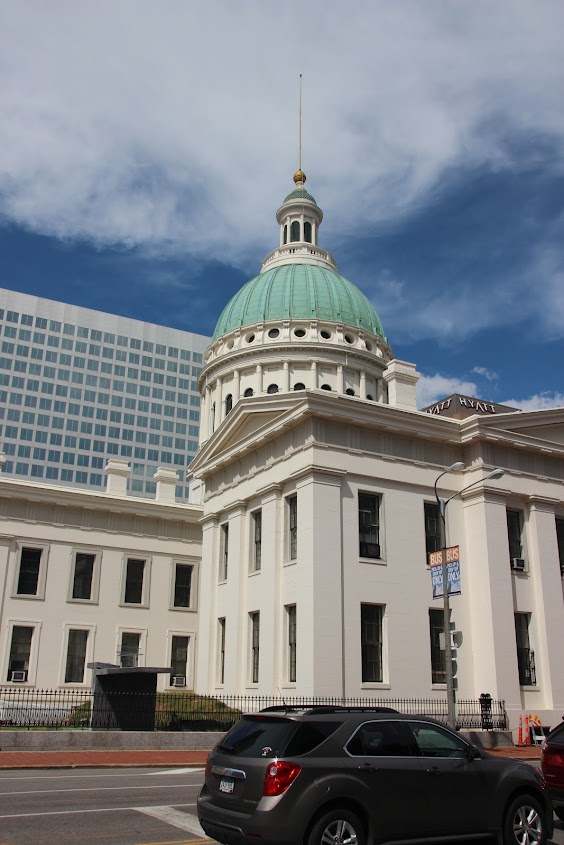
It might have been a little sunny that day.
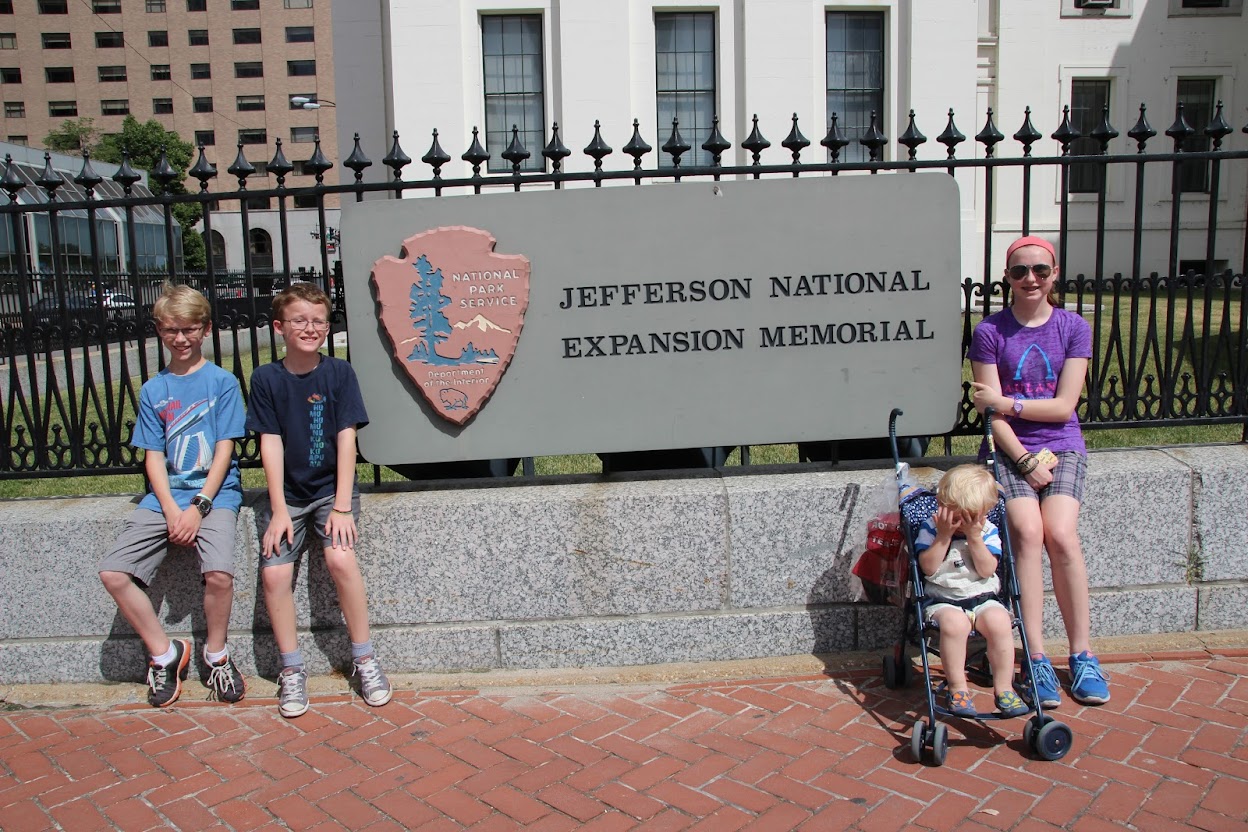
Courthouse interior:
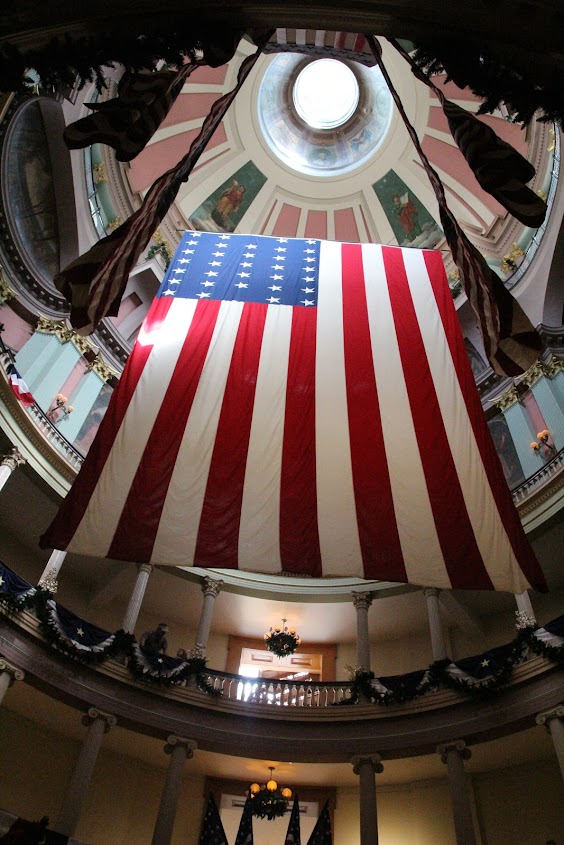
The Memorial celebrates both the Louisiana Purchase and the famed Lewis & Clark expedition. As President, Thomas Jefferson orchestrated the purchase of 828,000 square miles of land from France, land that presently includes fifteen states and portions of 2 Canadian provinces. It virtually doubled the size of the United States in one fell swoop. Once purchased, this land needed to be explored and mapped, so he dispatched two men, William Clark and Meriwether Lewis, to explore the territory. Their primary goal was to follow the Missouri River in the hopes of finding a waterway leading to the Pacific Ocean—a waterway linking the Atlantic Ocean (i.e. Gulf of Mexico) and the Pacific would be incredibly valuable to the nation that controlled it.
Unfortunately, no such waterway exists, as Lewis and Clark discovered. But their expedition did ultimately reach the Pacific, with great help from Native Americans, and was an instrumental part of this nation’s history.
The most famous landmark in the park is, of course, the Gateway Arch. This is a 630-foot tall steel structure designed by architect Eero Saarinen and built from 1963 – 1965. It is meant to symbolize St. Louis’ status as the “gateway to the west” and makes for a very striking addition to the city skyline. I have never been a huge fan of modern architecture, but I love how sleek and simple this structure is. It doesn’t hurt that there’s some fascinating engineering involved as well. Get ready for lots of photos.
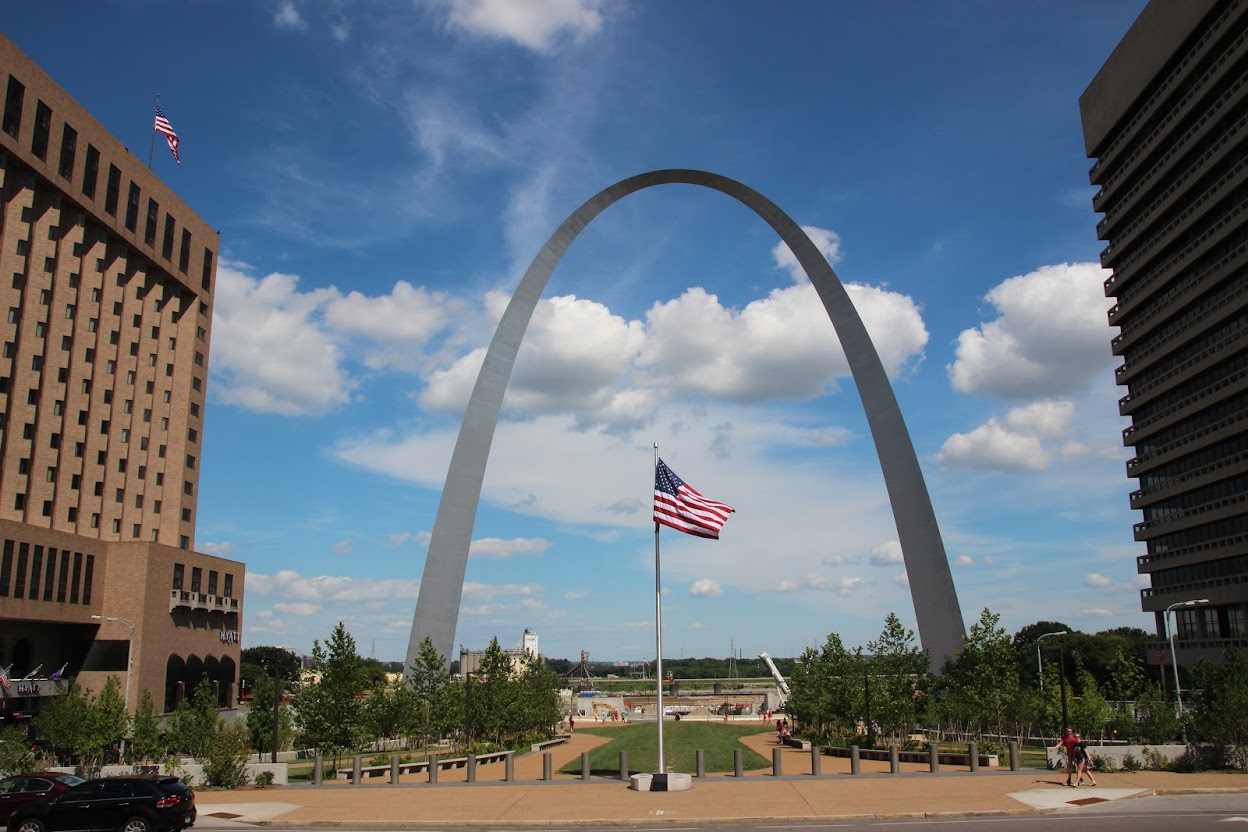
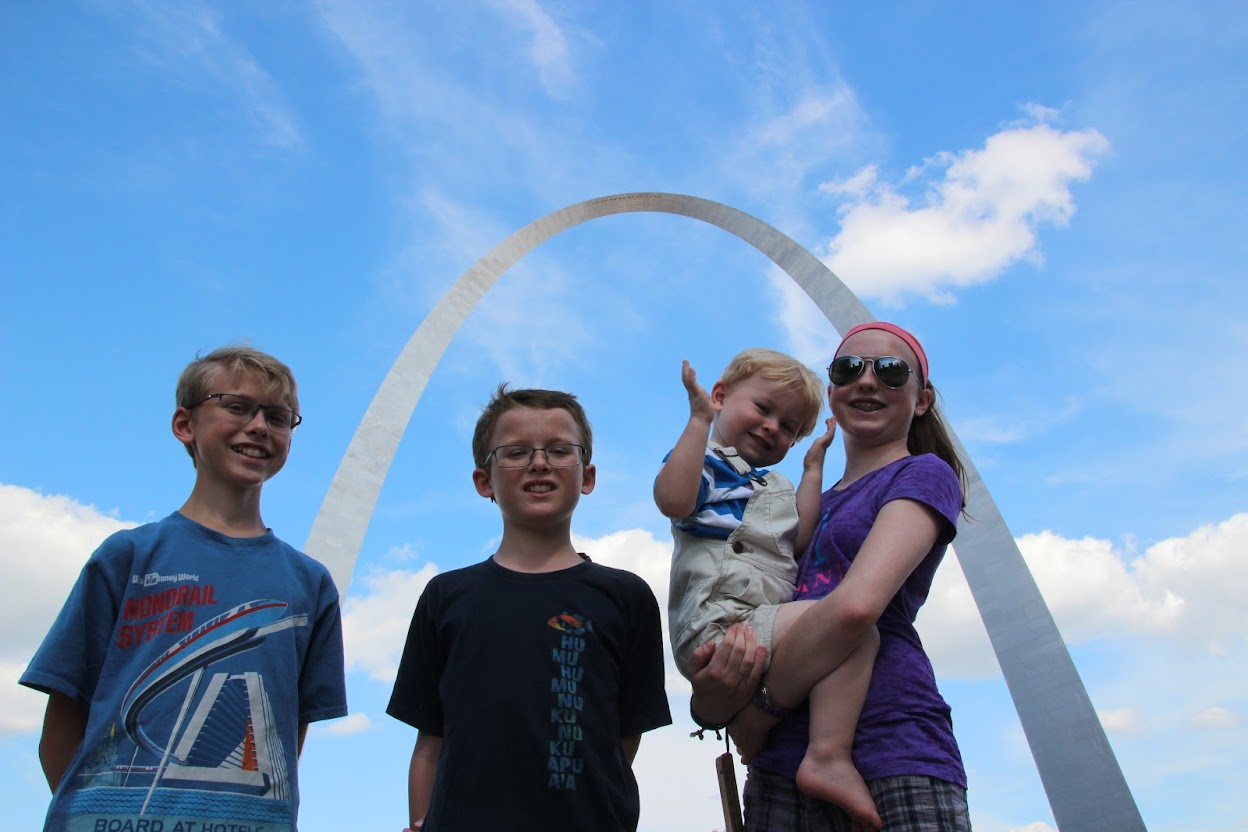
The arch was constructed by building both legs at once—and basically hoping that they met in the middle. The fact that they did is a testament to the men who designed and built it.
It may not look like it from ground level, but visitors can actually enter the arch and ride a lift up to the top, where there is an observation deck overlooking the city to the west, with the Mississippi River and Illinois to the east. When informed of the ability to ascend to the top, visitors usually have one of two reactions:
1) Cool! Or
2) NOPE.
I fit into the first category, and apparently enough people feel the same way to make the purchase of tickets in advance highly recommended. It’s not impossible to get tickets to go inside on the same day, but it depends on the crowds. I didn’t take any chances and got tickets a couple of months in advance. They’re timed for entry, but we found out that doesn’t mean much. Our tickets were timed for a 4:10 p.m. entry, but at 4:00 we got into a line that snaked out the door. It took about an hour to reach the “elevator”.
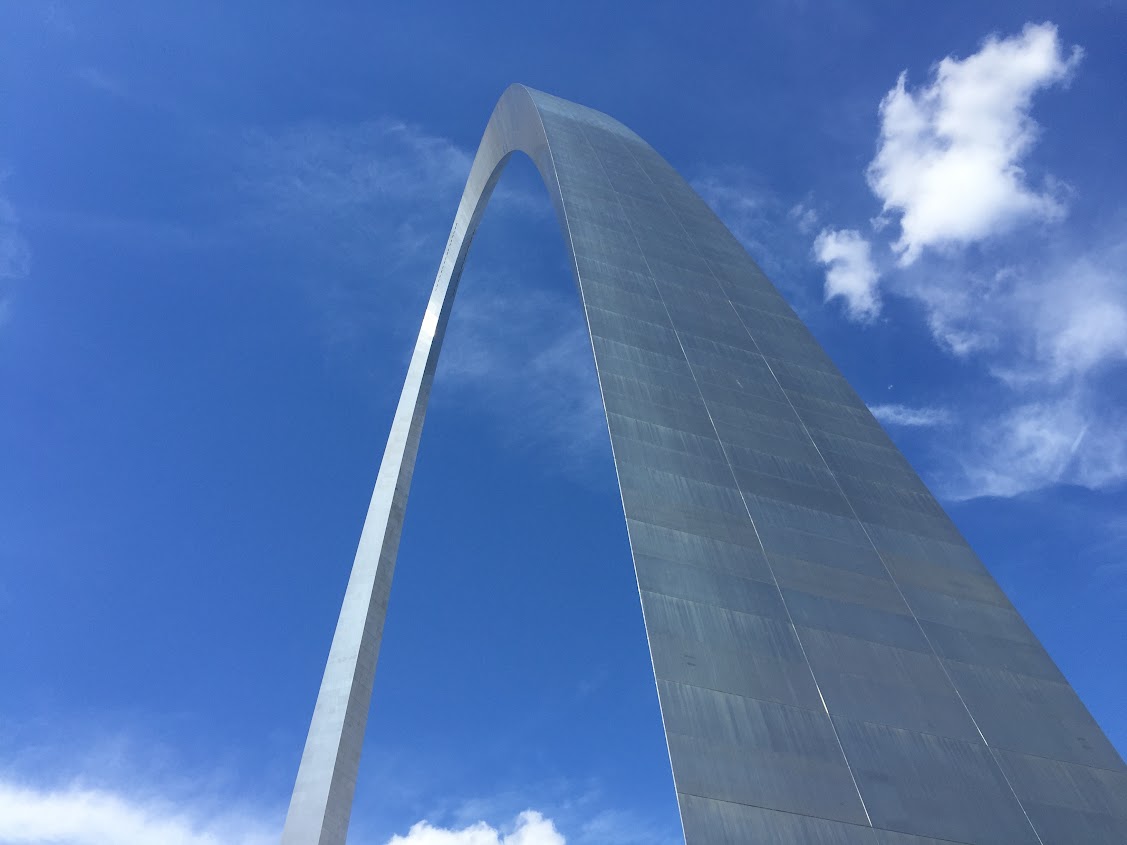
Here’s the Mississippi River. Quite a difference from the last time we saw it—when we crossed it on a log bridge.
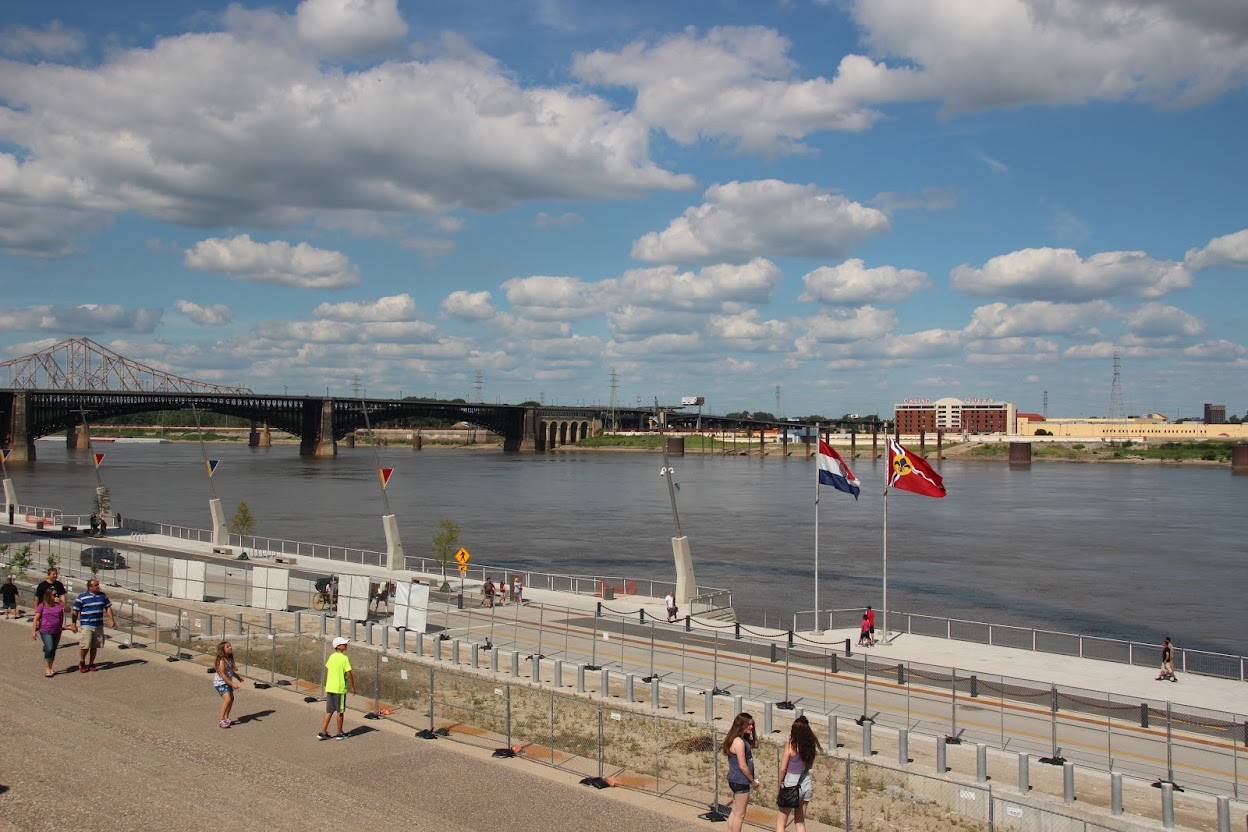
The observation deck in the arch is not large, and the lift system consists of seven pods linked together in a ball-and-chain type configuration. These pods can only hold five or six people at a time. The result of this cramped space means it gets overwhelmed by the demand, and the line takes a while to move. Additionally, you can stay up inside the observation deck as long as you want, and rangers are on hand keeping a count of everyone inside to make sure the capacity is not exceeded. All of these factors add up to a hefty wait in line, especially during peak tourist season.
The lift system (they call it the “tram”) is actually pretty ingenious. The legs of the arch are hollow but not wide, and the arch of course makes for a complicated path for an elevator to travel. Saarinen, the architect, visited an engineer named Richard Bowser and asked a simple question: “Does an elevator have to travel vertically?”
Bowser eventually came up with the pod system. It follows a track that moves horizontally underneath the arch, vertically up the side, and then wraps around to the top observation deck. Somehow the pods adjust every so often as you ascend so that you are always sitting in a position perpendicular to the ground. A simple drawing of the system:

We finally crammed ourselves into a pod. Everyone thought it was really cool, except for one who was only pretending to be happy about being lifted 630 feet off the ground in a cramped metal container.
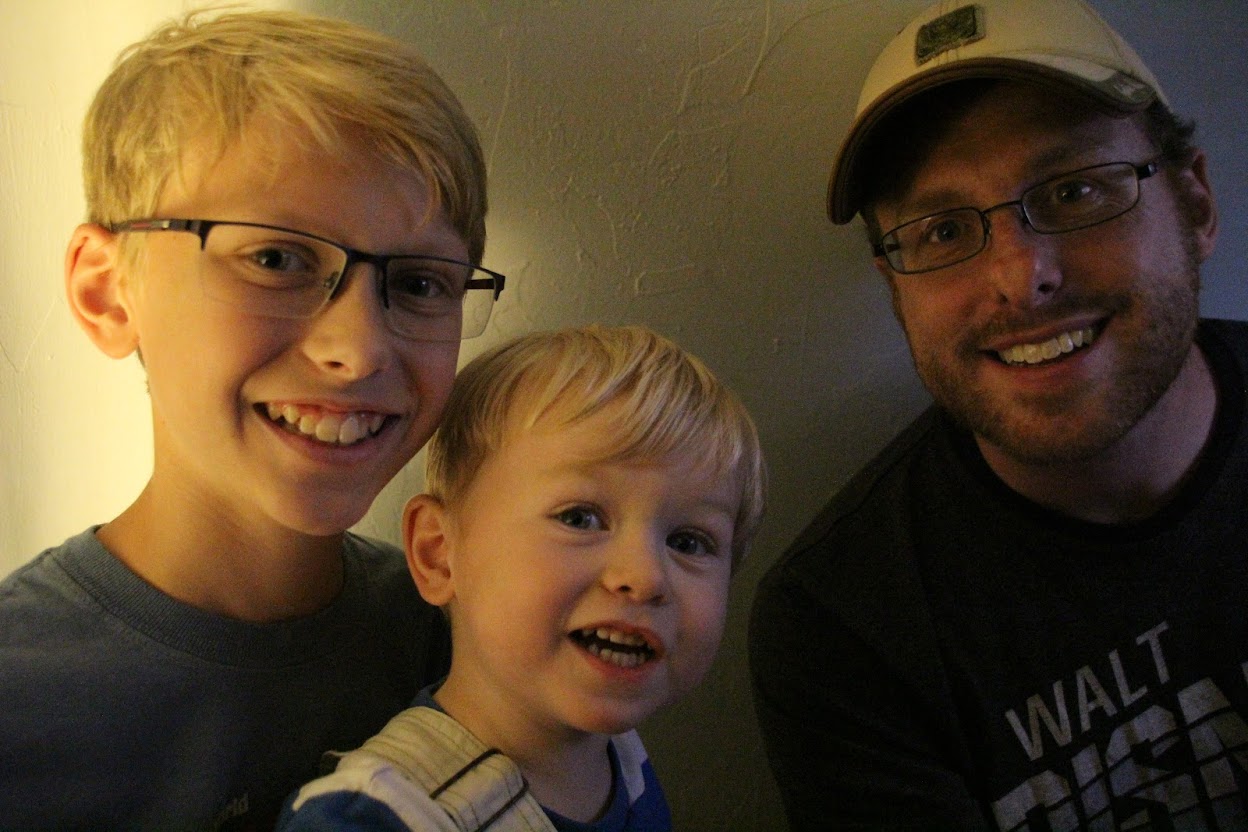
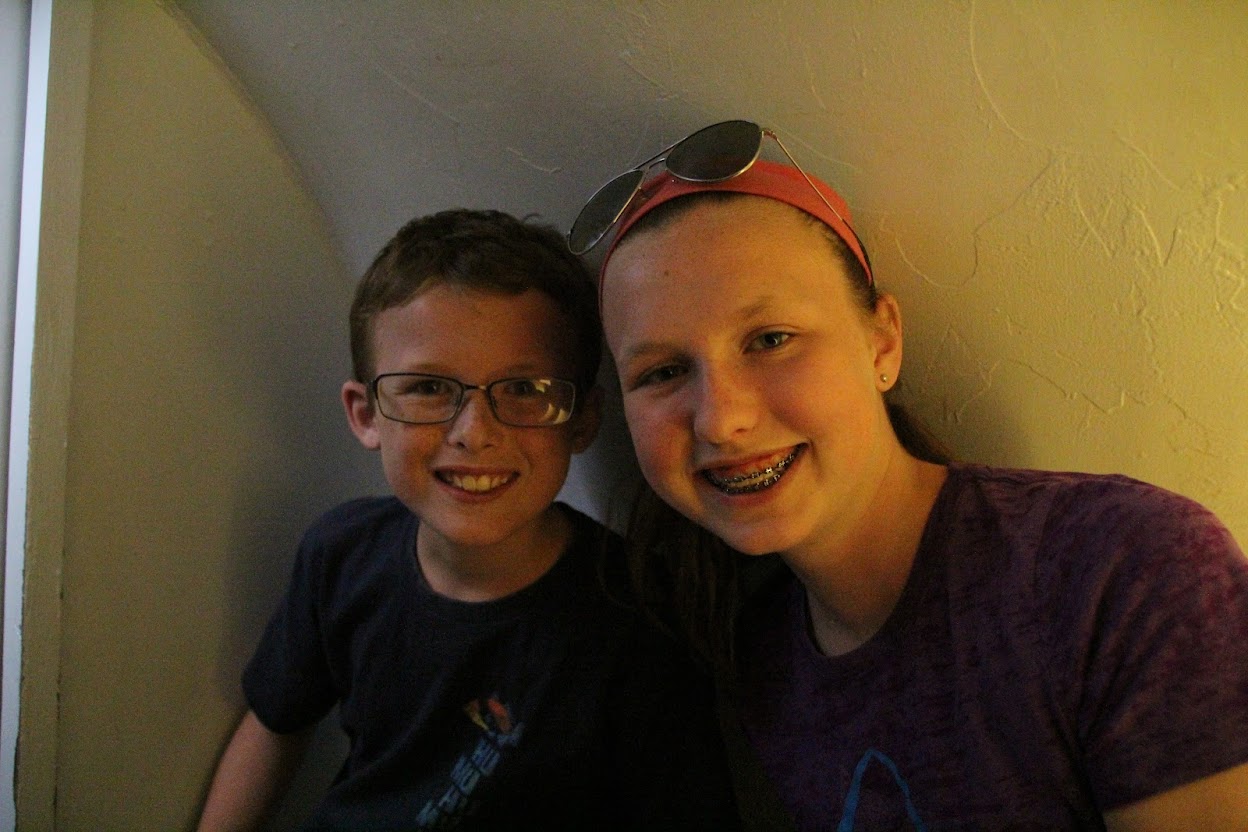

The door to the pod has a glass window, so you can see the framework of the arch the whole way up. When you finally reach the top, it’s crowded and hard to move around. The windows are tiny and somewhat smudged and you have to lean out on the wall to be able to see out of them.
But the view is pretty sweet:
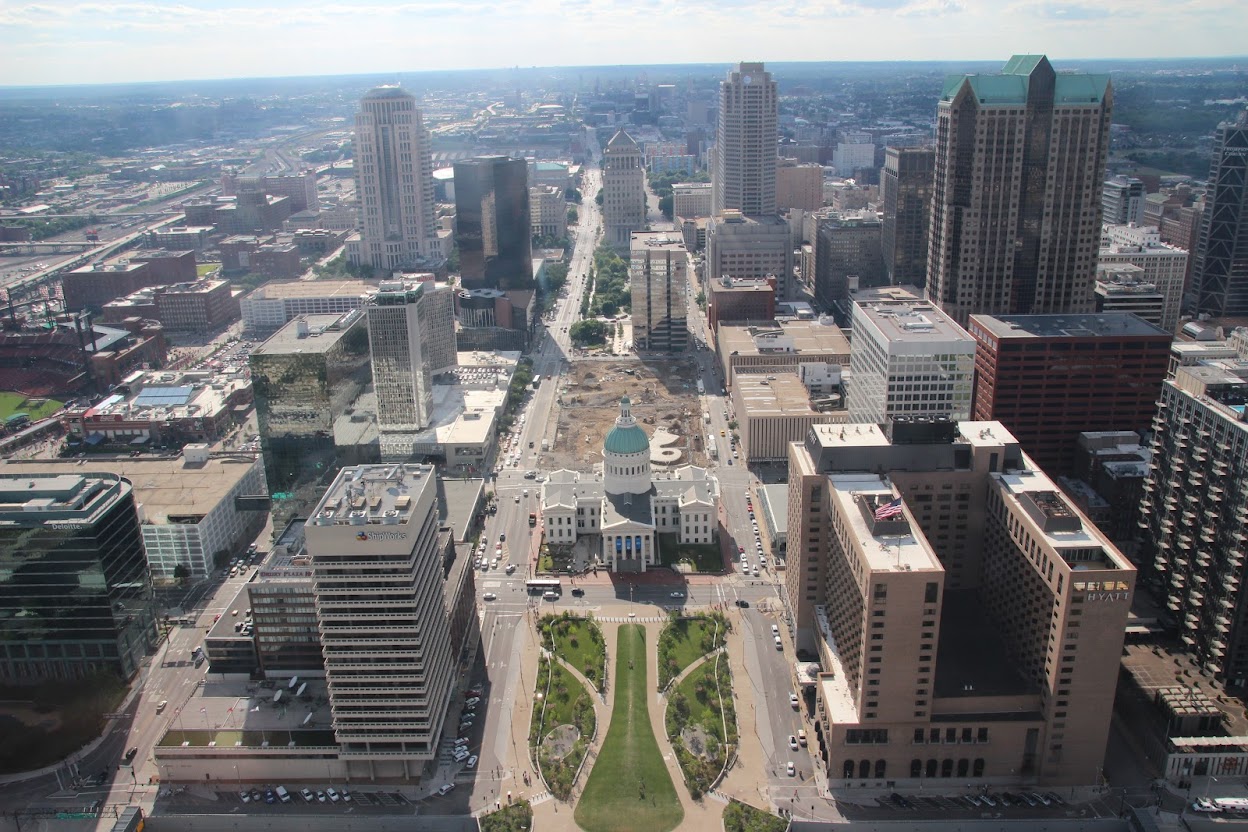
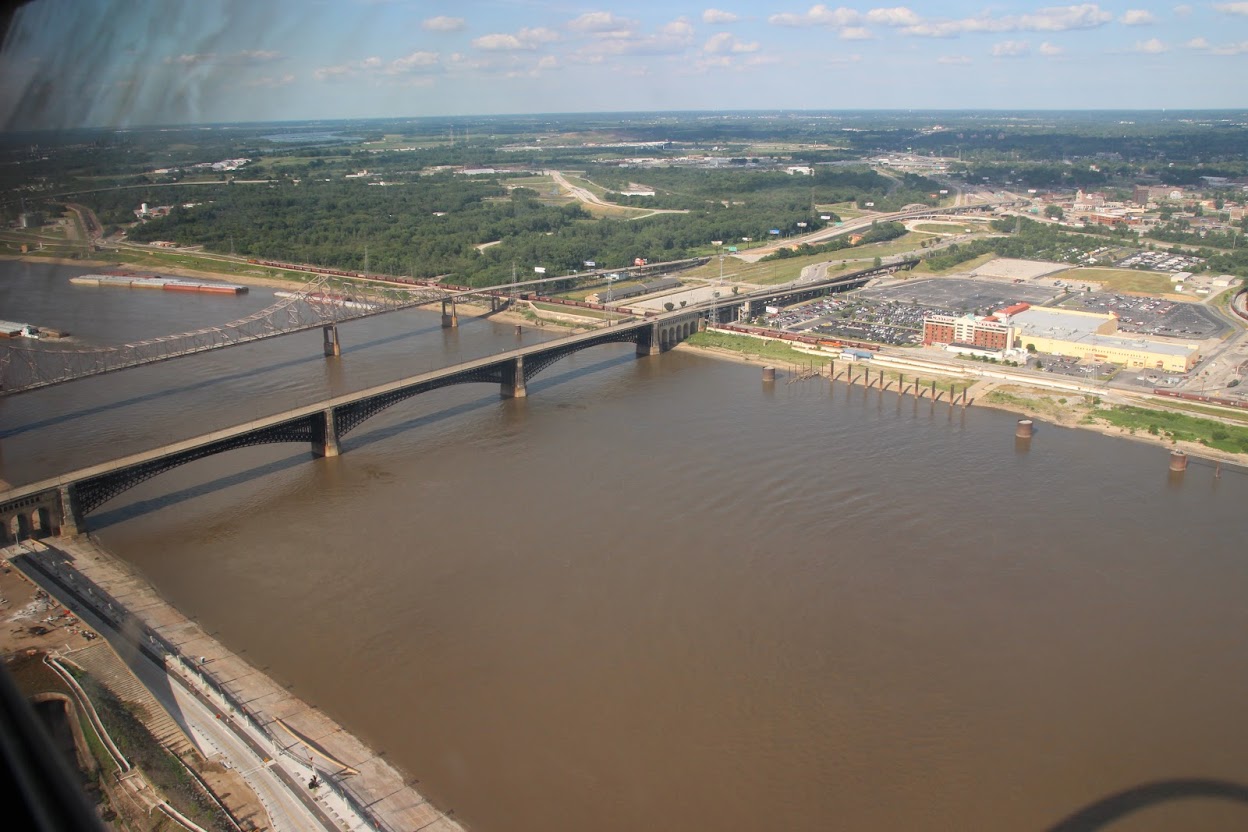
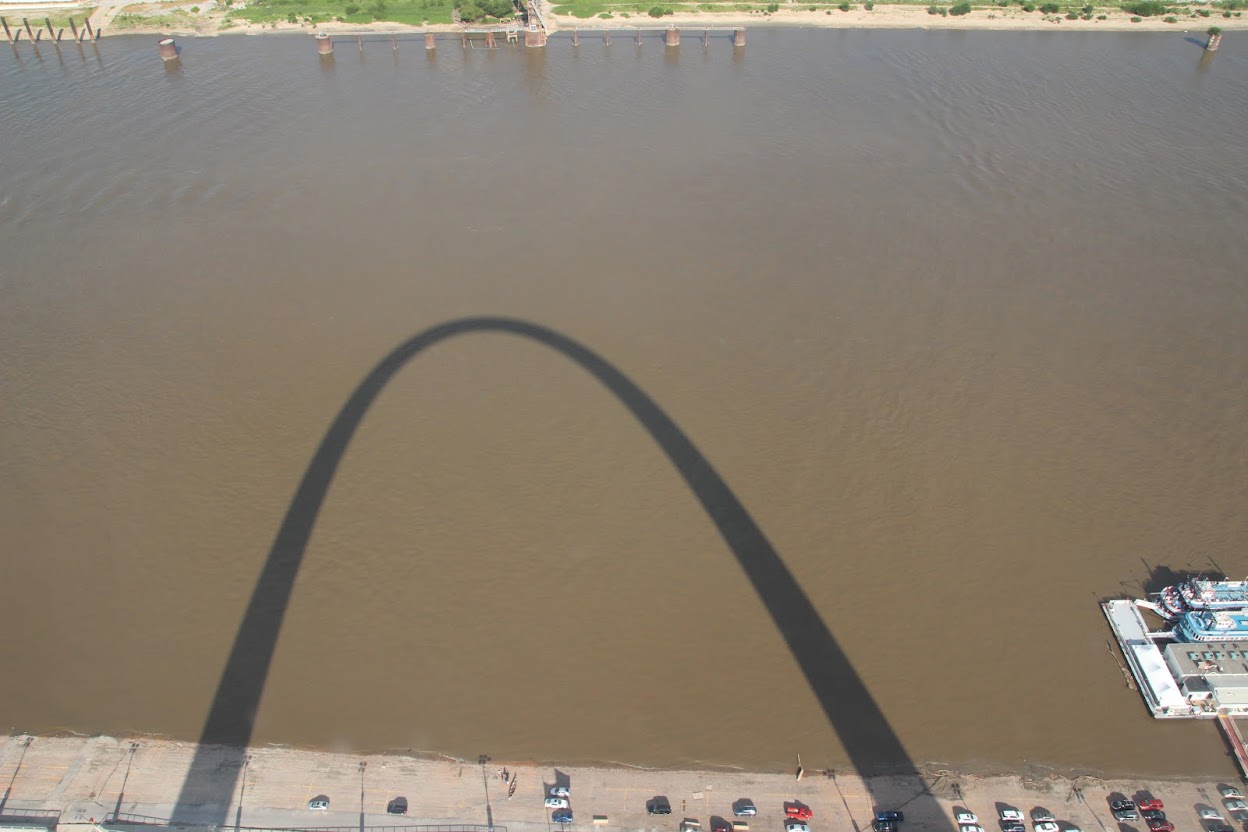
Oh, I forgot to mention one thing: the arch sways.
If the wind is blowing, you’ll definitely feel a noticeable sway as you’re in the observation deck. We were visiting on a calm day and didn’t really feel it, but it is present more often than not. This is NOT a design flaw. Tall skyscrapers and other buildings are actually designed to sway a bit in the wind. A structure with some flexibility is actually stronger than a completely rigid one. But that feeling can be unsettling.
In any case, we were all glad we visited (even Dave). I don’t think I’d choose to visit every time I was in town, but as a one-time tourist experience it fits the bill perfectly. And it is a true engineering marvel. @Flossbolna and @franandaj may even notice that I wore my Disney Imagineering t-shirt in honor of this visit.
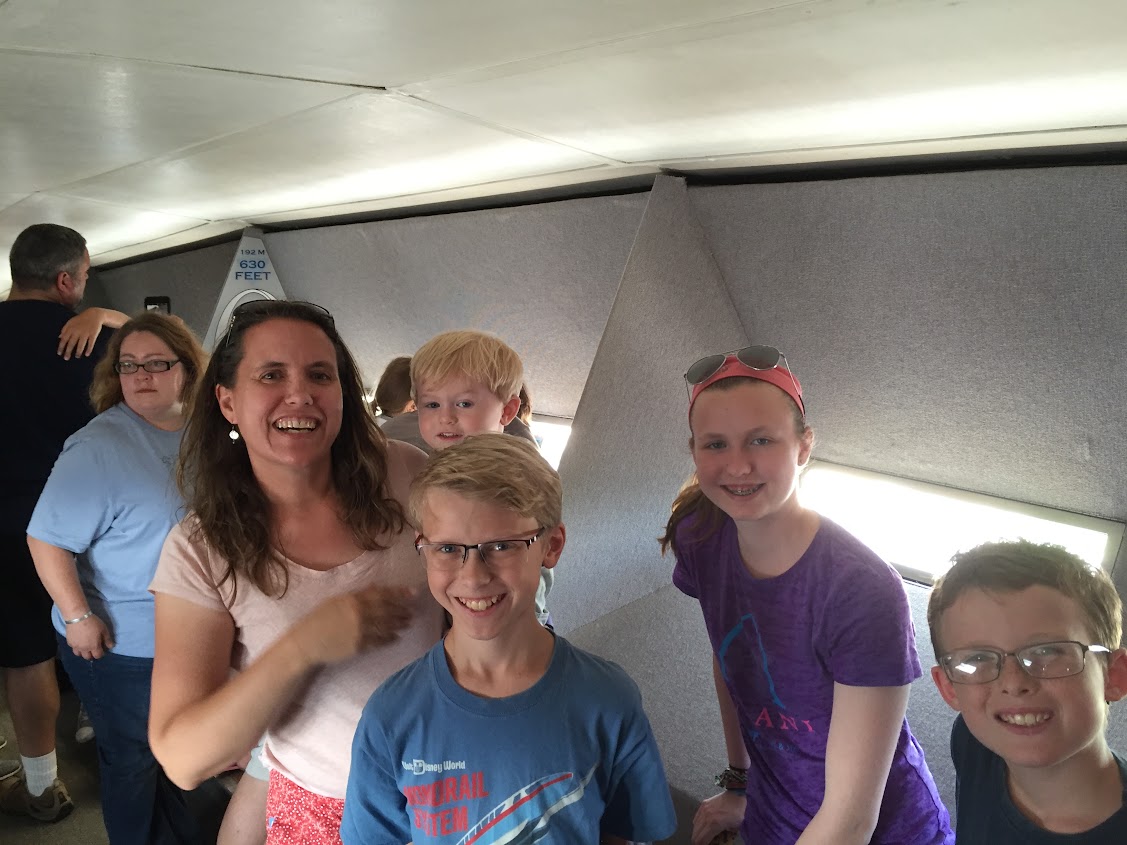
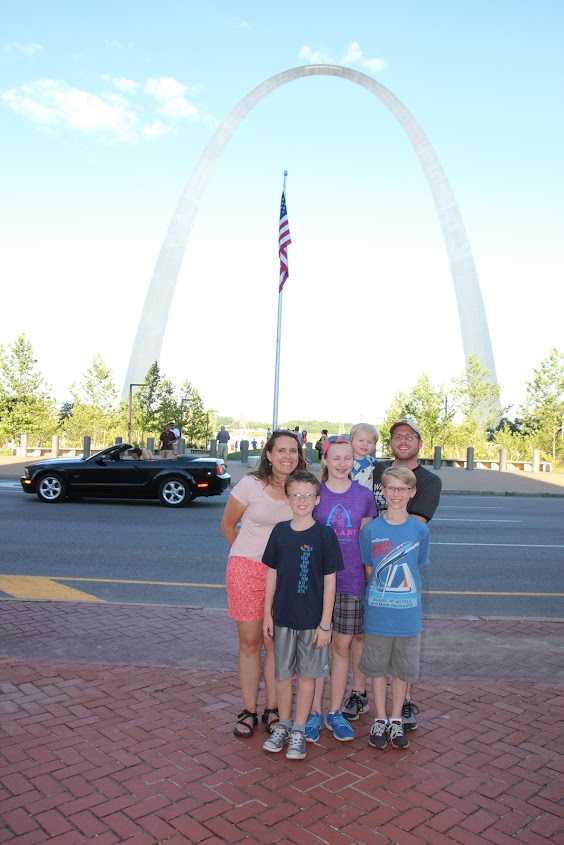
We had originally planned to eat in St. Louis, but the delay in getting to the top combined with the 90-minute drive we had ahead of us caused us to get on the road instead.
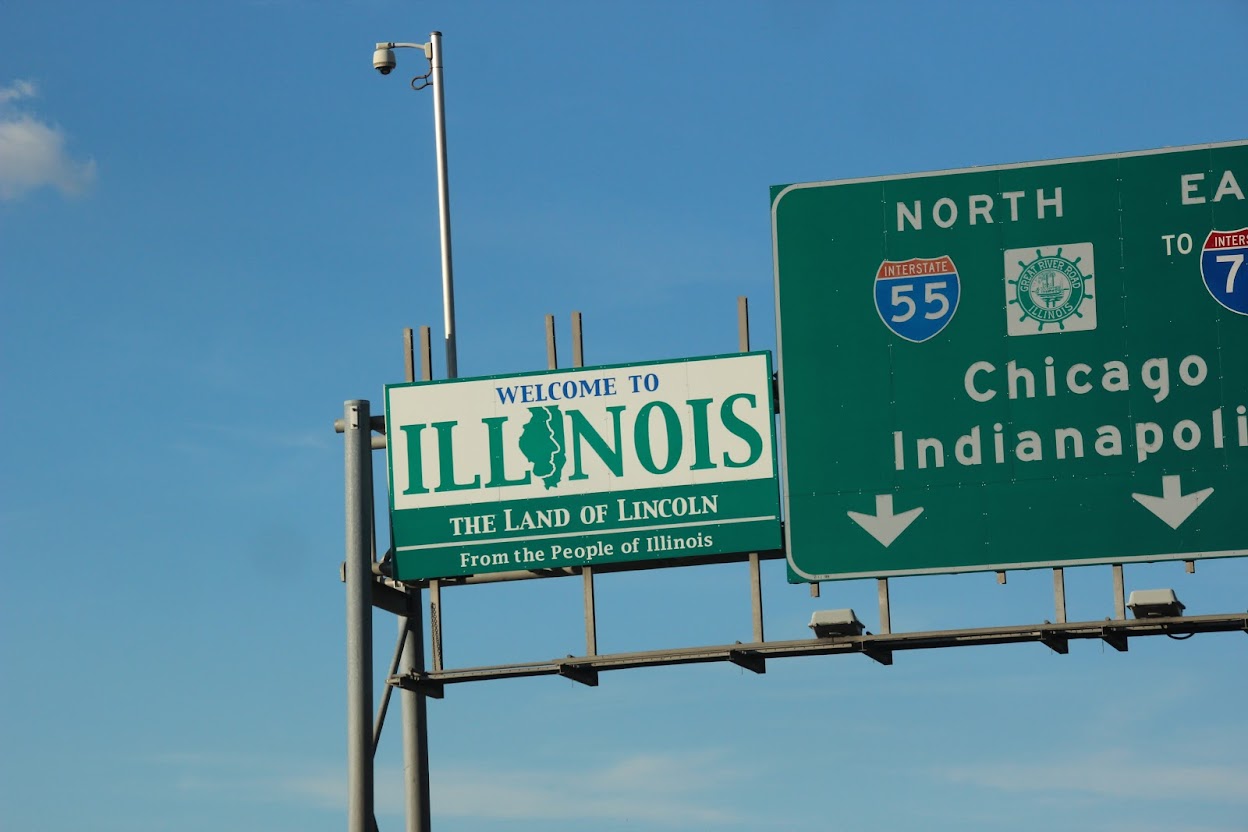
We opted for a quick fast-food meal at Culver’s, mostly so we could get custard and fried cheese curds. Oh, and some kale and arugula and healthy salads (not pictured).

Coming Up Next: Besides Disney World, our next destination is the very first repeat visit of any of our travels.
Here’s the best, most detailed, most exciting description I can muster for the morning’s drive from Kansas City across Missouri to St. Louis:
It took us four hours to get there.
We had our customary PB&J on the way and arrived just after noon. We found a parking space in a garage in downtown St. Louis right next to the new Busch Stadium, home of the St. Louis Cardinals. As it so happens, that was our destination.
Being a stereotypical red-blooded American male, I enjoy going to baseball games. My sons, also being stereotypical red-blooded American males, also enjoy going to baseball games. The girls, being stereotypical American females, would rather sit through a C-SPAN marathon than subject themselves to a baseball game. So, when planning these trips, I have to work to balance the boys’ desire to see games in various stadiums around the country versus the girls’ gag reflex. If you recall, we had originally held tickets to watch the Phillies play the Twins in Minneapolis on the first night of the trip, only to be forced to sell the tickets when our flight was cancelled. So we definitely owed the boys on that front.
I’d wanted to check out the St. Louis baseball stadium mostly because it was fairly new and had killer downtown views. St. Louis is well-known for being a big-time baseball town and I thought it would be fun to see a game in that atmosphere. However, in researching ticket prices for my family, I found that the cost would be roughly equal to buying my own cruise missile. I could really use a cruise missile, so I chose to save the money and not buy tickets to a game.
Instead, I went with my usual fallback plan, and got tickets for the stadium tour. In this case, the tour also included admission to the St. Louis Cardinals Museum next door to the stadium, so we headed there first.
The museum is, as you’d expect, an ode to all things Cardinals. Not being a Cardinals fan, I didn’t have a real attachment to anything in particular. However, they had some fun exhibits for the kids and some historical artifacts that appealed to me as a baseball fan.
For example, the greatest St. Louis Cardinal of all time is Stan Musial. In fact, he’s one of the greatest baseball players of all time. They had a copy of his original contract framed and on display, showing that he played for the princely sum of $750/month. Typical overpaid ballplayer.
Nearby was a sound booth where the kids could record themselves announcing a home run in the World Series. They had a great time with this, and definitely have a future…in something other than broadcasting.
At another exhibit, visitors had the chance to hold the actual bat used by a Cardinals great. The choices were Stan Musial, Ozzie Smith, Willie McGee, and some other dude. Honestly, as soon as I heard Musial, I knew what my choice was. None of the other players were close to his level.
There was a lady stationed at this exhibit whose sole purpose appeared to be to make sure that none of us could actually hold any of the bats for longer than 0.7 seconds. The Bat Nazi also helpfully positioned her chair right in the photo area and then badgered me the whole time about not being allowed to swing, making sure everyone got a turn, blah blah blah.
Lesson #1: Don’t annoy someone holding a baseball bat.
Anyway, we swallowed our irritation long enough to take some photos. I’m crowding the plate because of her stupid chair, so it looks like I’m just begging for the pitcher to bean me with a heater.
We finished up in the museum and walked across the street to Busch Stadium to meet up with our tour group. I always enjoy baseball stadium tours because you typically get to visit some of the off-limits areas of the stadium, such as the press box, luxury suites, and dugout.
For the most part, we enjoyed the tour. There were only two problems. First, our tour guide was an obvious trainee. The veteran guide was walking along behind us, and shared some history about Stan Musial at one point that indicated he was much more knowledgeable (and a much better story-teller) than Mr. Trainee. The second disappointment was that we would not be allowed on the field, because the Milwaukee Brewers were in town and decided they wanted to have some early batting practice well ahead of that night’s game. So we had to content ourselves with standing near the field. Stupid Brewers.
Some of the historic team logos were on display, including this one dubbed the original “Angry Bird”.
This led to Sarah’s Angry Bird impression:
We visited the press box and a luxury suite. And judging from the spray pattern of baseballs, I’m going to back off my initial feelings of disappointment. Clearly, the Milwaukee Brewers needed the extra practice.
Overall, the boys and I were glad to have been able to see the stadium and check out some of the exhibits. And the girls were glad that it didn’t last as long as a typical baseball game.
A walk of only a couple of blocks took us to the Old Courthouse, the temporary visitor center for the Jefferson National Expansion Memorial. The normal visitor center is actually located at the riverfront, right underneath the famed Gateway Arch. However, the entire riverfront area was undergoing a massive renovation at the time, so much of the park area bordering the Mississippi River was closed.
It might have been a little sunny that day.
Courthouse interior:
The Memorial celebrates both the Louisiana Purchase and the famed Lewis & Clark expedition. As President, Thomas Jefferson orchestrated the purchase of 828,000 square miles of land from France, land that presently includes fifteen states and portions of 2 Canadian provinces. It virtually doubled the size of the United States in one fell swoop. Once purchased, this land needed to be explored and mapped, so he dispatched two men, William Clark and Meriwether Lewis, to explore the territory. Their primary goal was to follow the Missouri River in the hopes of finding a waterway leading to the Pacific Ocean—a waterway linking the Atlantic Ocean (i.e. Gulf of Mexico) and the Pacific would be incredibly valuable to the nation that controlled it.
Unfortunately, no such waterway exists, as Lewis and Clark discovered. But their expedition did ultimately reach the Pacific, with great help from Native Americans, and was an instrumental part of this nation’s history.
The most famous landmark in the park is, of course, the Gateway Arch. This is a 630-foot tall steel structure designed by architect Eero Saarinen and built from 1963 – 1965. It is meant to symbolize St. Louis’ status as the “gateway to the west” and makes for a very striking addition to the city skyline. I have never been a huge fan of modern architecture, but I love how sleek and simple this structure is. It doesn’t hurt that there’s some fascinating engineering involved as well. Get ready for lots of photos.
The arch was constructed by building both legs at once—and basically hoping that they met in the middle. The fact that they did is a testament to the men who designed and built it.
It may not look like it from ground level, but visitors can actually enter the arch and ride a lift up to the top, where there is an observation deck overlooking the city to the west, with the Mississippi River and Illinois to the east. When informed of the ability to ascend to the top, visitors usually have one of two reactions:
1) Cool! Or
2) NOPE.
I fit into the first category, and apparently enough people feel the same way to make the purchase of tickets in advance highly recommended. It’s not impossible to get tickets to go inside on the same day, but it depends on the crowds. I didn’t take any chances and got tickets a couple of months in advance. They’re timed for entry, but we found out that doesn’t mean much. Our tickets were timed for a 4:10 p.m. entry, but at 4:00 we got into a line that snaked out the door. It took about an hour to reach the “elevator”.
Here’s the Mississippi River. Quite a difference from the last time we saw it—when we crossed it on a log bridge.
The observation deck in the arch is not large, and the lift system consists of seven pods linked together in a ball-and-chain type configuration. These pods can only hold five or six people at a time. The result of this cramped space means it gets overwhelmed by the demand, and the line takes a while to move. Additionally, you can stay up inside the observation deck as long as you want, and rangers are on hand keeping a count of everyone inside to make sure the capacity is not exceeded. All of these factors add up to a hefty wait in line, especially during peak tourist season.
The lift system (they call it the “tram”) is actually pretty ingenious. The legs of the arch are hollow but not wide, and the arch of course makes for a complicated path for an elevator to travel. Saarinen, the architect, visited an engineer named Richard Bowser and asked a simple question: “Does an elevator have to travel vertically?”
Bowser eventually came up with the pod system. It follows a track that moves horizontally underneath the arch, vertically up the side, and then wraps around to the top observation deck. Somehow the pods adjust every so often as you ascend so that you are always sitting in a position perpendicular to the ground. A simple drawing of the system:

We finally crammed ourselves into a pod. Everyone thought it was really cool, except for one who was only pretending to be happy about being lifted 630 feet off the ground in a cramped metal container.
The door to the pod has a glass window, so you can see the framework of the arch the whole way up. When you finally reach the top, it’s crowded and hard to move around. The windows are tiny and somewhat smudged and you have to lean out on the wall to be able to see out of them.
But the view is pretty sweet:
Oh, I forgot to mention one thing: the arch sways.
If the wind is blowing, you’ll definitely feel a noticeable sway as you’re in the observation deck. We were visiting on a calm day and didn’t really feel it, but it is present more often than not. This is NOT a design flaw. Tall skyscrapers and other buildings are actually designed to sway a bit in the wind. A structure with some flexibility is actually stronger than a completely rigid one. But that feeling can be unsettling.
In any case, we were all glad we visited (even Dave). I don’t think I’d choose to visit every time I was in town, but as a one-time tourist experience it fits the bill perfectly. And it is a true engineering marvel. @Flossbolna and @franandaj may even notice that I wore my Disney Imagineering t-shirt in honor of this visit.
We had originally planned to eat in St. Louis, but the delay in getting to the top combined with the 90-minute drive we had ahead of us caused us to get on the road instead.
We opted for a quick fast-food meal at Culver’s, mostly so we could get custard and fried cheese curds. Oh, and some kale and arugula and healthy salads (not pictured).
Coming Up Next: Besides Disney World, our next destination is the very first repeat visit of any of our travels.
 Not exactly something St. Louis is proud of, but definitely a slice of history.
Not exactly something St. Louis is proud of, but definitely a slice of history.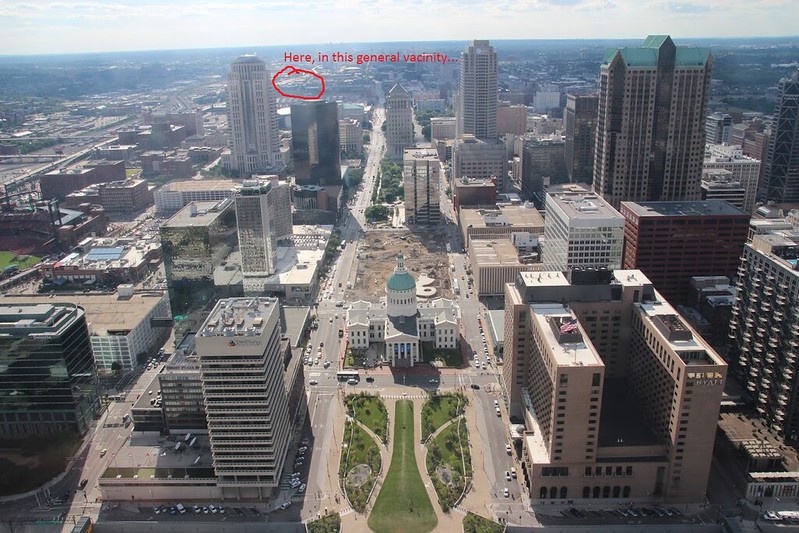


 Nope!
Nope!





 That couldn't have been fun to stay up there.
That couldn't have been fun to stay up there.


